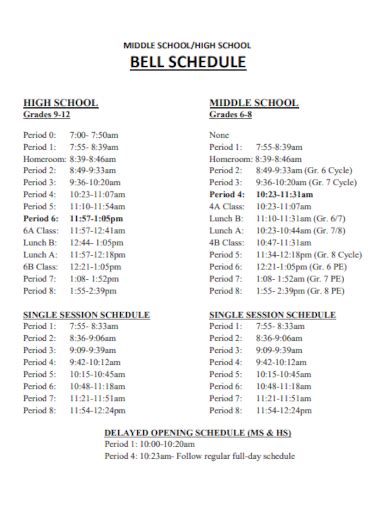Navigating high school requires a well-structured schedule that aligns with your academic goals, extracurricular activities, and personal commitments. An effective schedule helps you manage your time efficiently, prioritize tasks, and achieve academic success. This article provides a comprehensive example of a high school schedule that you can adapt to your own needs.

Common Pain Points in High School Scheduling
- Overwhelming workload: High school students often face a heavy course load, which leaves little time for other commitments.
- Difficulty balancing priorities: Balancing academic work, extracurricular activities, and personal time can be challenging.
- Procrastination and time management: Students may struggle with procrastination and difficulty staying on track with assignments.
- Stress and burnout: The pressure to succeed in school and extracurriculars can lead to stress and burnout.
Motivations for Creating an Effective Schedule
- Improved academic performance: A well-structured schedule allows you to prioritize assignments, study effectively, and improve your grades.
- Reduced stress and anxiety: When you know what you need to do and when, you feel more in control and less stressed.
- Increased productivity: By effectively managing your time, you can accomplish more tasks and have more free time.
- Improved work-life balance: A balanced schedule allows you to participate in extracurriculars, socialize, and pursue personal interests while still maintaining academic excellence.
Strategies for Crafting an Effective High School Schedule
- Identify priorities: Determine which classes, extracurricular activities, and personal commitments are most important to you.
- Create a realistic schedule: Don’t overbook yourself. Schedule time for breaks, studying, and activities you enjoy.
- Use a planner or calendar: Mark down all appointments, classes, activities, and deadlines to stay organized.
- Set priorities for each day: Identify the most important tasks to complete each day and work on them first.
- Break down large tasks: Divide assignments into smaller, more manageable chunks to make them less daunting.
- Take breaks: Schedule regular breaks throughout the day to prevent burnout and improve focus.
- Reward yourself: Set small rewards for completing tasks to stay motivated.
Common Mistakes to Avoid When Scheduling
- Overloading your schedule: Avoid taking on too many commitments or activities.
- Procrastinating: Don’t wait until the last minute to study or complete assignments.
- Not planning for breaks: Make sure to schedule time for breaks and activities you enjoy to prevent burnout.
- Being too rigid: Allow for some flexibility in your schedule to accommodate unexpected events.
- Not adjusting: Regularly review and adjust your schedule as needed to ensure it still meets your needs.
Sample High School Schedule
This sample schedule provides a framework for organizing your high school day. Adjust it to fit your specific needs and priorities.
| Time | Monday | Tuesday | Wednesday | Thursday | Friday |
|---|---|---|---|---|---|
| 7:00 AM | Wake up, get ready for school | Wake up, get ready for school | Wake up, get ready for school | Wake up, get ready for school | Wake up, get ready for school |
| 8:00 AM | First period: English | First period: Math | First period: Science | First period: Social Studies | First period: Foreign Language |
| 9:00 AM | Second period: Math | Second period: Science | Second period: Social Studies | Second period: English | Second period: Health |
| 10:00 AM | Third period: Physics | Third period: French | Third period: Spanish | Third period: Latin | Third period: Italian |
| 11:00 AM | Morning break | Morning break | Morning break | Morning break | Morning break |
| 11:30 AM | Fourth period: History | Fourth period: Psychology | Fourth period: Art | Fourth period: Music | Fourth period: Computer Science |
| 12:30 PM | Lunch break | Lunch break | Lunch break | Lunch break | Lunch break |
| 1:30 PM | Fifth period: Study hall | Fifth period: Study hall | Fifth period: Study hall | Fifth period: Study hall | Fifth period: Study hall |
| 2:30 PM | Sixth period: Elective | Sixth period: Elective | Sixth period: Elective | Sixth period: Elective | Sixth period: Elective |
| 3:30 PM | After-school club | After-school activity | Study time | After-school job | Volunteer work |
| 5:00 PM | Dinner | Dinner | Dinner | Dinner | Dinner |
| 6:00 PM | Homework | Homework | Homework | Homework | Homework |
| 8:00 PM | Free time | Free time | Free time | Free time | Free time |
| 10:00 PM | Bedtime | Bedtime | Bedtime | Bedtime | Bedtime |
Tips for Creating a Personalized Schedule
- Consider your learning style: Schedule study time when you are most focused and productive.
- Prioritize extracurricular activities: Schedule time for activities you enjoy and that contribute to your overall well-being.
- Set realistic expectations: Don’t try to do everything at once. Prioritize tasks and break them down into smaller steps.
- Be flexible: Allow for some flexibility in your schedule to accommodate unexpected events or changes in priorities.
- Regularly review and adjust: As your commitments and priorities change, adjust your schedule accordingly to ensure it still meets your needs.
Conclusion
Creating an effective high school schedule requires careful planning and consideration of your priorities, time management skills, and overall well-being. By following the recommendations in this article and using the sample schedule as a starting point, you can craft a schedule that helps you succeed in school, participate in extracurricular activities, and pursue your personal interests. Remember to regularly review and adjust your schedule to ensure it continues to meet your changing needs.
